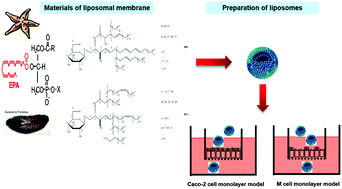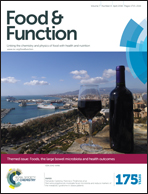Transport and uptake effects of marine complex lipid liposomes in small intestinal epithelial cell models
Abstract
Nowadays, marine complex lipids, including starfish phospholipids (SFP) and cerebrosides (SFC) separated from Asterias amurensis as well as sea cucumber phospholipids (SCP) and cerebrosides (SCC) isolated from Cucumaria frondosa, have received much attention because of their potent biological activities. However, little information is known on the transport and uptake of these lipids in liposome forms in small intestinal cells. Therefore, this study was undertaken to investigate the effects of these complex lipid liposomes on transport and uptake in Caco-2 and M cell monolayer models. The results revealed that SFP and SCP contained 42% and 47.9% eicosapentaenoic acid (EPA), respectively. The average particle sizes of liposomes prepared in this study were from 169 to 189 nm. We found that the transport of the liposomes across the M cell monolayer model was much higher than the Caco-2 cell monolayer model. The liposomes consisting of SFP or SCP showed significantly higher transport and uptake than soy phospholipid (soy-PL) liposomes in both Caco-2 and M cell monolayer models. Our results also exhibited that treatment with 1 mM liposomes composed of SFP or SCP for 3 h tended to increase the EPA content in phospholipid fractions of both differentiated Caco-2 and M cells. Moreover, it was also found that the hybrid liposomes consisting of SFP/SFC/cholesterol (Chol) revealed higher transport and uptake across the M cell monolayer in comparison with other liposomes. Furthermore, treatment with SFP/SFC/Chol liposomes could notably decrease the trans-epithelial electrical resistance (TEER) values of Caco-2 and M cell monolayers. The present data also showed that the cell viability of differentiated Caco-2 and M cells was not affected after the treatment with marine complex lipids or soy-PL liposomes. Based on the data in this study, it was suggested that marine complex lipid liposomes exhibit prominent transport and uptake in small intestinal epithelial cell models.


 Please wait while we load your content...
Please wait while we load your content...